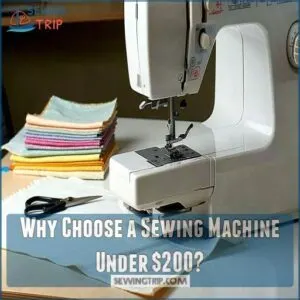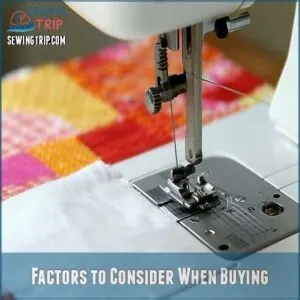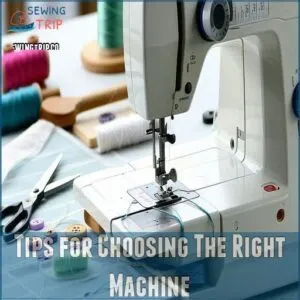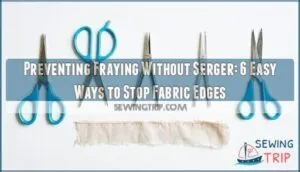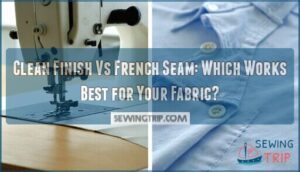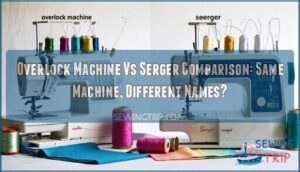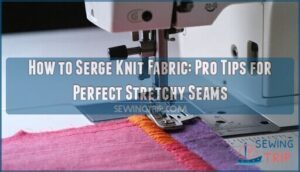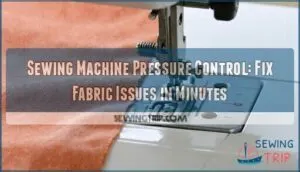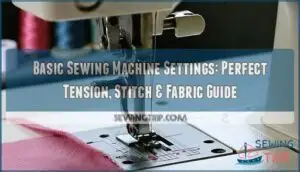This site is supported by our readers. We may earn a commission, at no cost to you, if you purchase through links.
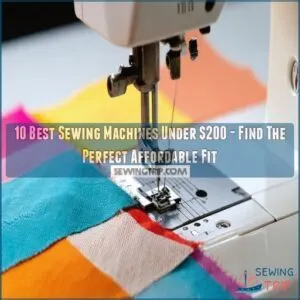 If you’re looking for the best sewing machine under $200, you’re in for a treat!
If you’re looking for the best sewing machine under $200, you’re in for a treat!
These affordable gems pack a punch with user-friendly controls and reliable stitch quality.
Whether you’re a sewing newbie or an occasional stitcher, an under-$200 machine can be your creative sidekick.
Explore feature-rich options from trusted brands like Brother and Singer – you’ll find the perfect balance of essential tools and budget-friendly value.
These machines are ideal for basic household tasks, from hemming curtains to repairing clothes.
With the right machine in your sewing corner, you’ll discover the joy of sewing without breaking the bank.
Ready to express your creativity on a budget?
Table Of Contents
- Key Takeaways
- Why Choose a Sewing Machine Under 200
- Top 10 Sewing Machines Under 200
- 1. Brother HC1850 Sewing Quilting Machine
- 2. Janome 2212 Sewing Machine
- 3. Singer Curvy 8763 Sewing Machine
- 4. Portable Mini Sewing Machine for Beginners
- 5. Singer Sewing Machine with 97 Stitches
- 6. Brother CS5055 Sewing Machine
- 7. Singer Heavy Duty Sewing Machine
- 8. Brother GX37 Sewing Machine
- 9. SINGER MX60 Sewing Machine
- 10. Singer Start 1304 Sewing Machine
- Factors to Consider When Buying
- Tips for Choosing The Right Machine
- Frequently Asked Questions (FAQs)
- Conclusion
Key Takeaways
- You can find feature-rich sewing machines from trusted brands like Brother and Singer under $200, perfect for beginners or occasional use.
- These affordable machines are ideal for basic household tasks, like hemming curtains and repairing clothes, without overwhelming complexity.
- Look for essential features like automatic buttonholers and versatile presser feet to streamline your sewing projects and handle various fabrics smoothly.
- Prioritize machines with good customer reviews and warranties to ensure reliability and a hassle-free sewing experience.
Why Choose a Sewing Machine Under 200
Choosing a sewing machine under $200 is ideal if you’re a beginner or just need a machine for basic household stitching.
These affordable, user-friendly machines offer a great balance of essential features without breaking the bank.
Beginner-Friendly Machines
Starting your sewing journey is exciting, and a sewing machine under $200 offers the perfect blend of ease and essential features without overwhelming complexity.
Look for intuitive models with helpful troubleshooting tips, and maintain your machine regularly for smooth operation.
Find the freedom and creativity you crave with the right beginner-friendly machine!
Balance of Features and Affordability
Sewing machines under $200 pack a punch by balancing essential features and affordability.
You can snag practical tools that cater to beginners without blowing your budget.
To find the perfect fit, explore various options, such as those listed at best sewing machines under 200.
These budget gems offer the perfect mix of versatility and value, empowering you to get started with sewing without buyer’s remorse.
It’s a sweet spot of price and performance.
Suitable for Basic Domestic Stitchwork
As a beginner, a sewing machine under $200 is perfect for tackling basic domestic stitchwork.
These machines offer user-friendly controls and reliable stitch quality, letting you sew like a pro without feeling overwhelmed.
Whether you’re repairing clothes, hemming curtains, or crafting simple projects, an affordable sewing machine can get the job done.
Value for Money
The sewing machines under $200 are a budget-friendly sweet spot, offering a balance of quality features and affordability.
Look for reliable brands like Brother and Singer that pack value into their cheaper models, such as the top 10 sewing machines under 200.
These affordable options let you explore sewing without breaking the bank, making them a smart choice for beginners and those on a tight budget.
Top 10 Sewing Machines Under 200
Looking to stitch up some affordable sewing projects? Explore our top 10 picks for the best sewing machines under $200, perfect for beginners and budget-conscious crafters alike.
1. Brother HC1850 Sewing Quilting Machine
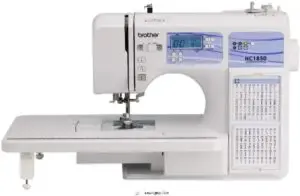
Considering the Brother HC1850 sewing and quilting machine?
This versatile powerhouse offers 130 stitches to conquer your creative ambitions.
Lightweight and portable, it’s perfect for mastering the art of sewing anywhere, thanks to features like an automatic needle threader and a handy LCD screen.
Ready to quilt? The detachable wide table has your back.
While it’s not ideal for heavy-duty fabrics, it’s a superb companion for budding sewists ready to express their creativity.
Best For: The Brother HC1850 is best for beginners and hobbyists seeking a user-friendly machine for sewing and quilting projects.
- Easy to use, even for beginners.
- Lightweight and portable.
- Includes a wide table for quilting projects.
- May be slow for some users.
- Doesn’t come with a case.
- Alphanumeric function may not be as high quality as some other machines.
2. Janome 2212 Sewing Machine
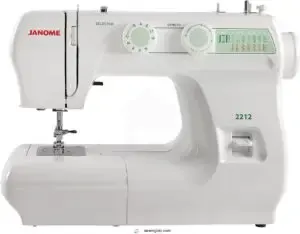
Wondering why the Janome 2212 sewing machine is such a hit among beginners and budget-conscious sewers?
This sturdy workhorse delivers solid performance without draining your wallet.
With 12 built-in stitches and a 4-step buttonhole, it’s perfect for tackling basic tasks like quilting or working with denim.
While manual threading takes some practice, you’ll appreciate its speed and efficiency.
Compact and affordable, the Janome 2212 lets your creativity shine without breaking the bank.
Best for those seeking a reliable machine for simple projects.
Best For: Beginners and budget-conscious sewers looking for a reliable machine for basic sewing tasks like quilting.
- Solid, no-thrill mechanical machine for routine sewing tasks.
- Durable and compares favorably to older mechanical machines.
- Good value for the price.
- Requires specialized accessories for 5mm front-load bobbin machines.
- The feed dogs will not raise immediately after switching to the raised position, they will only raise when the wheel is turned or the pedal is pressed.
- The bobbin area can be prone to thread jams, particularly when using poly-blend thread.
3. Singer Curvy 8763 Sewing Machine
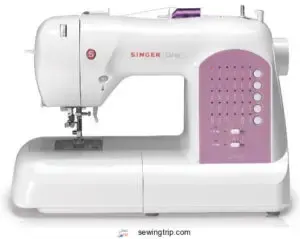
Frequently, the Singer Curvy 8763 is a fantastic option for intermediate sewers wanting a user-friendly machine that handles a variety of fabrics with ease.
With 30 built-in stitches and an automatic one-step buttonhole feature, this machine makes sewing projects a breeze.
The adjustable stitch settings and intuitive design allow even beginners to sew with confidence and flair.
Plus, the swift threading system and versatility for materials like denim and velour guarantee a smooth, snag-free sewing experience.
This is the perfect affordable machine for those seeking a hassle-free way to express their creativity.
Best For: The Singer Curvy 8763 is best for beginner to intermediate sewers looking for a user-friendly machine with a variety of features.
- Easy to use with intuitive controls and clear instructions
- Smooth and effortless stitching with adjustable stitch settings
- Versatile for various fabrics, including denim and velour
- Limited number of stitches compared to more advanced machines
- Some users reported confusion with the instruction manual
- Some users experienced issues with bobbin winding
4. Portable Mini Sewing Machine for Beginners
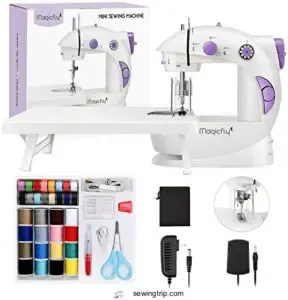
Seeking a compact and convenient sewing machine to kickstart your creative journey?
The portable SewMAX mini sewing machine is a great option.
Designed with beginners in mind, this lightweight marvel packs a punch with its dual-speed functionality, allowing you to sew at a pace that feels comfortable.
With push-button and foot pedal controls, stitching becomes almost effortless – just like riding a bike with training wheels.
While it lacks a backstitch feature, the SewMAX is perfect for mastering simple projects and honing your skills without breaking the bank.
Best For: Beginners, occasional sewers, and those seeking a compact and portable option for simple projects.
- Compact and lightweight design for easy portability.
- Dual-speed functionality for beginner-friendly sewing.
- Comes with a variety of accessories for a complete sewing experience.
- Limited stitch functionality (only one fixed stitch type, no backstitch).
- Some users have reported issues with tension adjustment and jamming.
- The LED light is dim and not directly over the work area.
5. Singer Sewing Machine with 97 Stitches
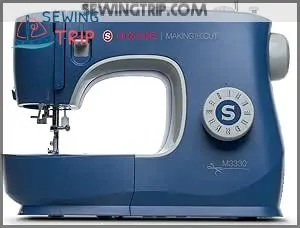
Considering a sewing machine with a generous 97 stitches?
The Singer M3330 "Making the Cut" edition delivers impressive versatility, empowering you to tackle everything from delicate fabrics to sturdy denim, making it an excellent choice for those seeking the best Singer sewing machine for beginners like the Singer Start 1304.
With adjustable stitch length and width, you can customize your stitches to perfection.
The built-in needle threader takes the hassle out of threading, while the one-step buttonhole guarantees professional-looking results every time.
Whether you’re an aspiring designer or a home decor enthusiast, this Singer machine is your ticket to sewing success.
Best For: This Singer sewing machine is best for beginners and experienced sewers who want a versatile machine with a wide range of stitches and features.
- Offers a large selection of stitches (97).
- Features a built-in needle threader and one-step buttonhole.
- Comes with adjustable stitch length and width for customization.
- No manual included, which can be challenging for beginners.
- Reports of initial setup and bobbin issues.
- Some users have reported thread tangling and jamming issues.
6. Brother CS5055 Sewing Machine
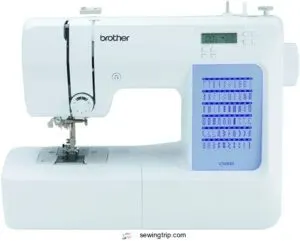
If you’re after a dependable sewing companion under $200, the Brother CS5055 is a great option.
It’s versatile yet easy to use with 60 built-in stitches, a semi-automatic needle threader, and digital adjustments.
While it may not handle heavy-duty tasks, the CS5055 is perfect for beginners and casual sewers seeking a user-friendly machine.
7. Singer Heavy Duty Sewing Machine
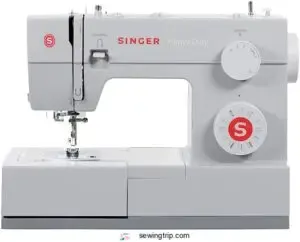
The Singer Heavy Duty 4423 sewing machine is a rugged workhorse that can tackle tough projects without busting your budget.
With 23 built-in stitches and a powerful motor, this machine plows through thick fabrics like denim and leather.
While the foot pedal may feel a bit jumpy at first, a little practice helps you master its responsive controls.
This reliable companion offers the freedom and versatility you crave, making it a great pick for beginners and intermediate sewers who want an affordable, durable machine.
Best For: Beginners and intermediate sewers who want a durable and affordable machine for tackling tough projects.
- Handles heavy fabrics like denim and leather with ease.
- Reliable and durable, with a heavy-duty metal frame and a stainless steel bedframe.
- Offers a variety of stitches for basic projects.
- Some reviewers reported problems with the machine straight out of the box.
- The foot pedal can be a bit jumpy to control.
- It may not have the same advanced features as higher-end machines.
8. Brother GX37 Sewing Machine
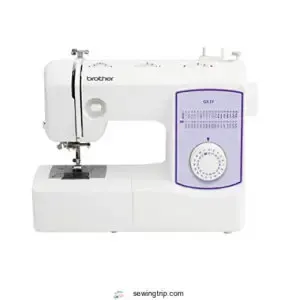
Two hundred dollars may not seem like a lot, but the Brother GX37 sewing machine proves you don’t have to break the bank to get a quality machine.
You can find additional Brother GX37 products and accessories at Brother GX37 Supplies.
This lightweight dynamo boasts 37 built-in stitches, an automatic needle threader, and a drop-in top bobbin – features that make it a breeze for beginners to master.
While it may struggle with heavy fabrics, its smooth operation and sturdiness make it a go-to for everyday projects.
At this price point, the GX37 offers unbeatable value, earning its spot as an excellent choice for casual sewists.
Best For: The Brother GX37 is best for beginner to intermediate sewers looking for a user-friendly machine with basic features.
- Easy to use, even for beginners.
- Produces balanced seams.
- Offers excellent value for the price.
- The built-in storage compartment is not well-designed.
- The LED light is dim.
- The presser foot lever is awkward to raise.
9. SINGER MX60 Sewing Machine
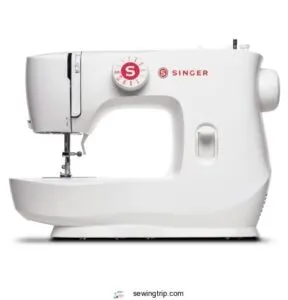
Are you a sewing newbie looking to explore your creativity on a budget?
The SINGER MX60 is a great choice.
This lightweight marvel packs an impressive 57 stitches, yet keeps things simple with intuitive dials and preset options.
Perfect for mending, crafting, and quilting, the MX60 is a user-friendly companion to master the basics without breaking the bank.
Key Features:
- 57 Built-In Stitches
- Lightweight and Portable Design
- Straightforward Dial Controls
- Great Value Under $200
10. Singer Start 1304 Sewing Machine
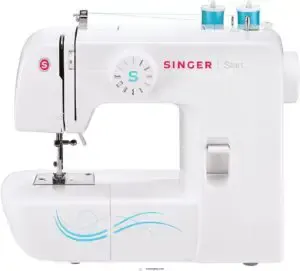
If you’re an aspiring sewer seeking an affordable yet capable machine, the Singer Start 1304 may be your perfect match.
Boasting six built-in stitches, this lightweight beauty is ideal for beginners honing their skills or those tackling simple projects.
Its user-friendly design and automatic bobbin winding make it a breeze to operate, while the generous 25-year limited warranty provides peace of mind.
Whether you’re stitching classroom crafts or mending household items, the Singer Start 1304 offers the ideal balance of affordability and functionality to kickstart your sewing journey.
Best For: Beginners and those who need a basic machine for mending or simple sewing projects.
- Lightweight and portable
- Easy to use and learn
- 25-year limited warranty
- Limited stitch options
- No instruction manual included
- Designed for use in the US and Canada only
Factors to Consider When Buying
When shopping for a sewing machine under $200, it’s important to keep in mind your budget and sewing needs.
Don’t forget to look for key features like an automatic buttonholer and a variety of presser feet and stitches to make sure your new machine can handle all your projects.
Budget and Sewing Needs
When looking for a sewing machine under $200, think about your budget and sewing needs.
It’s like finding a comfy pair of shoes that fits just right.
Prioritize features for beginner projects and different fabric types.
Machines like the Singer MX60 and Brother GX37 offer easy threading and versatile stitches, making them perfect for honing your sewing skills.
Automatic Buttonholer and Presser Feet
Choosing a sewing machine under 200 bucks? Automatic buttonholer and versatile presser feet can make all the difference. They streamline buttonholes, tackle zippers, and handle fabrics smoothly, keeping frustration at bay. Here’s why they’re your sewing sidekicks:
- Automatic Buttonholer: Saves time, less hassle.
- Presser Foot Types: Essential for varied tasks.
- Foot Functions: Guarantee smooth stitching adventures.
Variety of Stitches and Sewing Surface
Exploring the range of stitch types and the sewing surface size is like crafting your own adventure in creativity.
Seek a sewing machine that offers multiple stitch patterns, ensuring it fits various fabric types and styles.
For inspiration and guidance on various sewing machine stitches, consider exploring specialized resources like Sewing Machine Stitches.
A roomy sewing space makes handling quilts and larger projects a breeze.
Automated features lighten your workload, enhancing overall stitch quality.
Tips for Choosing The Right Machine
When choosing the right sewing machine under $200, consider your sewing goals and look for machines that come with essential accessories.
Don’t forget to check the warranty and customer support to make sure you have a hassle-free sewing experience.
Consider Your Sewing Goals
To truly master your sewing projects, focus on your sewing goals—whether you’re creating unique garments or quilting like a pro.
Match your machine to your skill level and frequency.
Beginner? Start with mechanical machines for tactile learning.
Intermediate sewers might crave more intricate features.
Consider the fabric types and garment variety you’ll tackle, and choose accordingly.
Sew happy decisions!
Look for Machines With Essential Accessories
When shopping for a sewing machine under $200, look for accessory bundles that fit your needs.
These extras, like presser feet and bobbins, are budget-friendly tools that’ll boost your creativity.
Think of them as superhero sidekicks – essential for a smooth sewing journey.
Don’t let accessories limit your potential; choose a machine that empowers you.
Check The Warranty and Customer Support
Check the length of the warranty – some machines come with a 25-year limited warranty, giving you peace of mind.
Peruse customer reviews to gauge the brand’s reputation for responsive customer support.
Knowing repair costs and the return policy can also help you choose a machine that fits your needs and budget.
Practice and Enjoy The Process of Learning to Sew
Embrace the journey of sewing – it’s as much about the process as the end result.
Take time to play, experiment, and savor each stitch.
Join local sewing groups or online communities to share tips, swap stories, and discover new techniques.
Most importantly, remember that every project is a chance to grow, so enjoy the ride.
Frequently Asked Questions (FAQs)
Should you buy a sewing machine under $200?
Consider your sewing needs – if you’re just getting started or need basic functionality, a $200 machine can be a smart investment.
Look for one with essential features and positive reviews from other beginners.
What is the best sewing machine?
The best sewing machine is one that fits your sewing needs and skill level.
Consider factors like stitch options, ease of use, and durability to find the perfect match for your projects and budget.
Which luxury sewing machine should you buy?
Indulge in the ultimate sewing experience with a luxury machine that elevates your creativity. Explore a world of advanced features and exceptional craftsmanship to take your projects to new heights.
How do I find the best sewing machines?
Whether you’re sewing your first project or tackling tough fabrics, the right machine makes all the difference.
Discover features like user-friendly controls, versatile stitches, and durability to power your next sewing adventure.
Is the brother se600 a good sewing machine?
You’re considering the Brother SE600—it’s solid for sewing and embroidery with versatile features.
You get 80 designs, 103 stitches, and a color touch screen; perfect for creative projects, though pricier than basic models.
Which Janome Sewing Machine is best?
Janome’s New Home line offers a sweet spot of quality and affordability.
HD3000 Heavy Duty boasts a full metal interior, robust motor, and easy-to-use features.
This makes it an excellent choice for hobbyists and artisans on a budget.
What is the most reliable brand of sewing machine?
The most reliable sewing machine brand is Singer.
They’re known for their quality construction, user-friendly features, and excellent customer support.
With a Singer, you can count on a smooth, dependable sewing experience that’ll have you stitching with confidence.
What is the average price of a good sewing machine?
Based on my web search, a decent sewing machine can typically be purchased for around $200 these days.
This price point offers a good balance of quality and affordability, suitable for both beginners and experienced sewers looking to tackle a variety of projects.
Is Brother or singer better?
Choosing between Brother and Singer sewing machines hinges on your needs.
Brother offers more tech features ideal for newbies, while Singer boasts durability for heavy-duty projects.
Both brands deliver reliability; it’s a matter of personal preference.
What is a good first time sewing machine?
A sewing machine is your gateway to creativity, like a brush in an artist’s hand.
For newbies, consider the user-friendly Singer MX 60 or Brother GX
They’re affordable, easy to handle, and offer essential features.
Conclusion
Finding the best sewing machine under $200 is like discovering a hidden treasure in the fabric world.
You’ve got an excellent guide with these top picks from Brother and Singer, equipped with essential features for everyday projects.
They offer the perfect balance of affordability and functionality, whether you’re hemming pants or exploring new designs.
By considering your needs and these reliable options, you can easily find a machine that sparks your creativity and fits your budget seamlessly.

